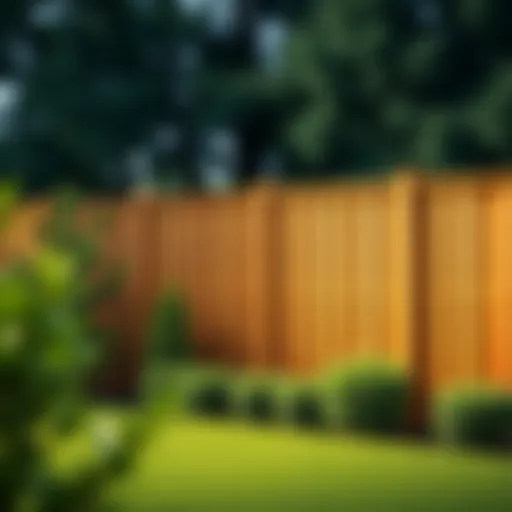Best Curtain Ideas for Living Room Spaces
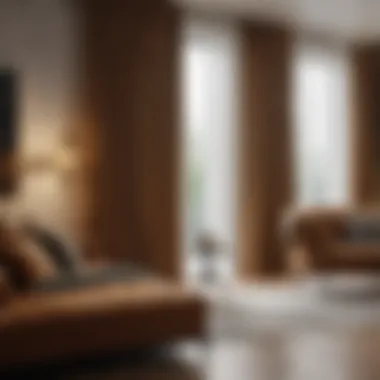

Intro
Choosing the right curtains for your living room can significantly impact the overall aesthetic and atmosphere of the space. Curtains serve multiple roles; they add style, provide privacy, and can enhance energy efficiency. With several designs and materials available, selecting curtains might seem overwhelming. However, understanding various curtain ideas can simplify this process, offering you the means to create a visually appealing and functional environment.
By exploring the world of curtain design, you can effectively curate a living area that reflects your personal style while remaining practical for everyday use. This article will delve into different design inspirations, trending styles, and color palettes, as well as maintenance tips to ensure your curtains always look pristine.
"Curtains are not just practical; they are a crucial part of the room's identity."
Design Inspirations
To begin the journey of selecting curtains, it is essential to look at various design inspirations. This aspect is not just about the curtains themselves but how they blend with the overall room design.
Trending Styles
Several styles are currently trending in interior design regarding curtains. One popular option is sheer curtains, which allow natural light to filter through, creating a warm and inviting atmosphere. These can be layered with heavier drapes for added privacy and warmth in colder months.
Another style gaining traction is the use of patterned curtains. These can serve as a focal point in a room, especially when the rest of the decor is more subdued. Floral, geometric, or abstract designs can add personality and visual interest, making your living room feel both vibrant and unique.
For a more minimalist approach, consider solid-color curtains in rich fabrics like velvet or linen. These materials drape beautifully and can elevate the perceived sophistication of the room. Alternatively, blackout curtains are becoming a favorable choice for those who prioritize light control and tranquility, ensuring restful days and nights.
Color Palettes
The choice of color for your curtains can affect the mood of your living room. Neutral tones such as beige, taupe, or soft greys create a calming environment and can complement various design elements.
On the flip side, bold colors can invigorate your space. Deep blues, emerald greens, and burnt oranges are excellent choices if you wish to make a statement. To create cohesion in your living room, you might opt for curtains that pick up colors from your furniture or artwork, tying the whole space together.
In addition, consider the seasonality of colors. Lighter, brighter hues can breathe freshness into your space during spring and summer, while richer, deeper shades may provide a cozy feel in the fall and winter. Mixing textures can also enhance the overall design, with combinations like silk and cotton adding depth to your living room.
Maintenance and Upkeep
Selecting the right curtains is only the first step; maintaining them ensures they remain an asset to your living room. This section will focus on practical maintenance tips.
Seasonal Maintenance Checklist
- Check for Damage: Regularly inspect curtains for any signs of wear, tear or fading, especially after seasonal changes.
- Clean Regularly: Dust and dirt can accumulate on curtains. At least bi-annually, consider cleaning them to keep them fresh.
- Adjust for Seasons: For example, consider switching to lighter fabrics in warmer months and heavier materials in winter for insulation.
Cleaning and Organization Tips
For cleaning, always refer to the manufacturer's guidelines. Some curtains can be machine washed, while others require dry cleaning. Here are some general tips:
- Dusting: Use a vacuum with a brush attachment or a lint roller monthly to remove dust.
- Spot Treatment: Address stains promptly with appropriate solutions to prevent permanent marks.
- Storage: When not in use, store curtains in a dry place to avoid mildew, and keep them in breathable fabric bags to keep them dust-free.
By being informed and proactive about design inspirations and maintenance, you can elevate your living room with curtains that are both functional and aesthetically pleasing.
Foreword to Living Room Curtains
Curtains play a pivotal role in the design and functionality of a living room. They influence both aesthetics and practical aspects. At their core, curtains are not only a barrier against light but also a fundamental element of style. They frame windows and can dramatically alter a room's atmosphere.
In this section, we will explore several key points about living room curtains. First, consider the ability of curtains to enhance privacy. For homeowners, this is a significant concern. Properly selected curtains allow one to enjoy the natural light while keeping the outside world at bay.
Another important aspect is how curtains can contribute to thermal insulation, affecting energy efficiency. This can lead to cost savings on heating and cooling. Households that opt for thermal curtains may notice a difference in their energy bills. Additionally, curtains help with sound dampening, creating a more tranquil environment.
Aesthetic appeal is a critical reason why curtains should be chosen with thoughtfulness. The right curtains can complement the theme and color palette of a living room. They can make a space feel inviting, cozy, or even sophisticated. With countless options available, understanding the variety in styles, colors, and materials is essential for informed decision-making.
Another consideration is maintenance. Depending on the fabric, some curtains require more upkeep. Knowing what to expect can help in choosing the right materials without overwhelming oneself with constant cleaning or care.
In summary, various elements come into play when selecting curtains for a living room. From privacy and energy efficiency to aesthetics and maintenance, each consideration is significant, making a strong case for a careful approach to curtain selection. Understanding these factors allows homeowners, interior design enthusiasts, and hosts to make informed decisions that align with their unique needs and tastes.
Importance of Curtains in Living Room Design
Curtains serve more than just a practical purpose in your living room. They play a vital role in the overall design and ambiance of the space. When chosen correctly, curtains can transform a room, making it feel more inviting and comfortable.
One of the primary benefits of curtains is their ability to regulate light. Depending on the type and fabric, curtains can control how much natural light enters the room. Sheer curtains allow soft light to filter in, creating a warm atmosphere, whereas blackout curtains provide privacy and reduce glare, particularly if you watch television or work in the living room.
Another factor to consider is insulation. Thermal curtains can help maintain a stable temperature, keeping the room cooler in the summer and warmer in the winter. This contributes not only to comfort but also to energy savings. It is an understated but significant means of improving home efficiency.
Moreover, curtains contribute to sound absorption. A well-placed set of heavy drapes can dampen echoes and outside noise, providing a quieter environment. This is particularly beneficial in lively urban areas.
When selecting curtains, aesthetics also play a crucial role. The choice of colors, patterns, and textures can enhance the style of your living room. For example, bold prints can serve as a focal point, while neutral tones can create a calming effect.
Curtains can also provide a cohesive look that ties different elements of the room together. By matching curtains with cushions, rugs, or other accessories, you can create a harmonious visual flow that enhances the overall design aesthetic.
"Curtains are not just about blocking light; they are a vital design element that can influence mood, comfort, and energy efficiency."
In essence, curtains are essential in living room design. They contribute to light control, insulation, sound absorption, and visual aesthetics. They are a practical solution with a significant impact on the space's overall feel. Consider these aspects carefully when choosing curtains to ensure that they enrich your living environment.
Types of Curtains: An Overview
Curtains serve both functional and aesthetic roles in a living room. Understanding the different types of curtains available can significantly impact the overall ambiance of the space. Each type offers unique features, benefits, and considerations for homeowners. Identifying the correct curtain type can influence light control, privacy, insulation, and style. Here is a closer look at the different kinds of curtains.
Sheer Curtains
Sheer curtains are often chosen for their light and airy qualities. They allow natural light to permeate while providing a level of privacy without blocking out the view. This type of curtain is ideal for achieving a soft, inviting atmosphere. Additionally, sheer curtains can complement other types of window treatments, such as blinds or thicker drapes. The key characteristic of sheer curtains is their delicate fabric, typically made from polyester or lightweight cotton. However, sheer curtains may not offer sufficient privacy or light control at night.
Blackout Curtains
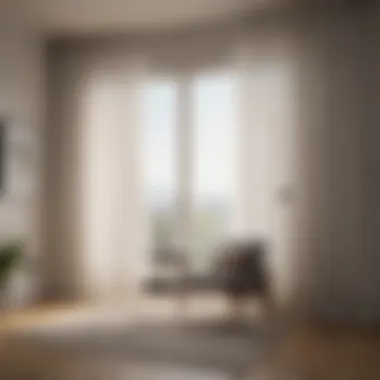

Blackout curtains are designed for maximum light blockage. They are excellent for bedrooms or media rooms where darkness is preferred for sleep or movie-watching. These curtains are typically lined with a thick, opaque material to eliminate outside light, making them highly suitable for those who work night shifts or have irregular sleeping patterns. The main advantage of blackout curtains is their versatility in light control and temperature regulation, providing insulation against heat and cold. A drawback is that they may not lend an open, airy feel to a room, as their purpose is to block light entirely.
Thermal Curtains
Thermal curtains are an innovative solution for homeowners looking to improve energy efficiency. These curtains feature a special lining that helps maintain indoor temperatures by regulating heat transfer. They can keep rooms warmer in winter and cooler in summer. The key advantage of thermal curtains is their ability to reduce energy costs while providing comfort. However, like blackout curtains, they can appear bulkier than other options, which might impact the overall decor of the living room.
Specialty Curtains
Specialty curtains encompass a range of curtain designs tailored to meet unique needs or preferences. These often include:
- Valances: Valances are decorative pieces that hang across the top of windows, offering an elegant finish without covering the entire window. They draw attention to the window shape and can be made from various materials. Valances are especially popular for their ability to add color and style while allowing light and view from the window.
- Draperies: Draperies are heavy and elegant curtains that extend from the window top to the floor. They offer great insulation and light control, making them a staple in traditional designs. Drapery has a luxurious appeal and can enhance the sophistication of a living room, but they often require careful maintenance and cleaning due to their weight and material.
- Panel Curtains: Panel curtains are versatile and come in various patterns and materials. They are typically sold as separate panels that can be drawn to one side or opened in the middle. They can be styled to fit both modern and traditional settings. The flexible nature of panel curtains allows homeowners to adjust light levels easily, but organizing multiple panels can be more cumbersome than simpler options.
Selecting the Right Material
Choosing the right material for curtains is essential in achieving both aesthetic appeal and functionality. The material impacts how curtains hang, their ability to block light, and their durability. Different materials can set the mood and style of your living room. Therefore, it is crucial to consider factors such as texture, color fastness, and the ease of maintenance when making this decision.
Natural Fibers
Natural fibers are a popular choice for curtains due to their unique characteristics and ecological benefits. They usually offer a more organic and sophisticated look, enhancing the warmth of any space.
Cotton
Cotton is a widely recognized fabric known for its versatility and softness. Its breathability makes it a comfortable choice for various climates. Cotton curtains allow for light control while still maintaining privacy. One key characteristic of cotton is its ability to be easily dyed, which means it comes in a multitude of colors.
However, cotton can wrinkle easily, which might require regular ironing. It is also less resistant to fading when exposed to prolonged sunlight, so careful consideration of placement is necessary to maintain its vibrant look over time.
Linen
Linen is appreciated for its textured appearance and high cost effectiveness. Its natural luster contributes to a more sophisticated atmosphere, making it suitable for a variety of styles from casual to formal. Linen drapes beautifully, adding an elegant touch to living rooms. It is a highly breathable material.
Nevertheless, linen also wrinkles easily, which might not appeal to everyone. Regular maintenance is required to keep linen curtains looking their best. Its tendency to absorb moisture may affect how it performs in humid environments, needing extra consideration for selection.
Wool
Wool is less common in sheer curtains but offers excellent insulation properties. Its dense weave allows it to control heat loss, making it a functional choice for energy-efficient homes. Wool also possesses a natural resistance to dirt and stains. The distinctive texture of wool provides a cozy or luxurious feel to the living room space.
However, wool can be expensive compared to other materials. It might also require special cleaning to preserve its structure and look. Those with allergies might find wool problematic, as it can trap dust and allergens.
Synthetic Fabrics
Synthetic fabrics offer an array of practical benefits, often being more affordable and durable than natural options. They tend to resist wrinkles and fading, making them a low-maintenance choice for busy households.
Polyester
Polyester is a popular synthetic option due to its durability and ease of care. It is resistant to shrinking, stretching, and wrinkles, making it an ideal choice for households with children or pets. Polyester curtains can easily maintain their shape and look for extended periods.
However, they may not provide the natural breathability found in cotton or linen, which could lead to a less comfortable environment in warmer weather.
Nylon
Nylon is another synthetic fabric that is lightweight and extremely strong. It has a silky appearance and resists wrinkles well. Nylon curtains offer a sleek and modern look, which can elevate the design of the living room.
The downside to nylon is its tendency to attract static electricity, which can lead to a clingy appearance. It may also be less eco-friendly compared to natural materials, which could be a consideration for environmentally conscious homeowners.
Blends
Blended fabrics, often made with a mix of natural and synthetic fibers, combine the best properties of each type. For instance, a cotton-polyester blend can provide the softness of cotton while enhancing durability and wrinkle-resistance thanks to polyester. This versatility makes blends a beneficial choice for those looking to balance aesthetics and functionality.
However, the specific qualities can vary widely depending on the exact composition of the blend. Homeowners are advised to examine the fabric mixture and consider the performance and feel of the curtains before making a final choice.
Choosing the right material is crucial for the performance and style of your curtains. It reflects your taste and fulfills your needs.
Curtain Colors and Patterns
Curtain colors and patterns significantly influence the aesthetic of a living room. They set the mood and can alter the perception of space. Choosing the right colors and patterns can enhance the interior design while reflecting personal style. Solid colors offer simplicity and versatility, allowing other elements in the room to stand out. On the other hand, patterns can add visual interest and can be used to create focal points in the room.
In this section, we will examine solid colors and various types of patterned curtains. Understanding these elements will empower homeowners to make informed decisions that harmonize with their overall decor.
Solid Colors
Solid color curtains serve as a blank canvas. Their simplicity allows them to seamlessly integrate with different design elements in your living room. A well-chosen solid color can complement walls, furniture, and accents without competing for attention. Neutral tones like beige, grey, or whites can create a calm atmosphere. Alternatively, vibrant colors like royal blue or deep red can act as bold statements, energizing a space.
One key advantage of solid colors is their flexibility. They can adapt to seasonal decor changes, such as warm colors in winter and pastels in spring. However, a potential downside is that they may lack personality if not selected mindfully.
Patterned Curtains
Patterned curtains provide a dynamic option, bringing personality and life to spaces. They can range from subtle textures to bold designs. Let’s explore three popular types of patterns:
Floral
Floral curtains are often associated with warmth and comfort. They tend to evoke feelings of nature and renewal. The variety in floral designs can make a room feel inviting and cheerful. A key characteristic of floral patterns is their intricate detailing, allowing for a range of colors and sizes.
Using floral curtains is a beneficial choice for creating a soft, nostalgic atmosphere. However, they might clash with other busy patterns present in the room, so careful selection is essential to maintain balance.
Geometric
Geometric patterns introduce a sense of modernity into living spaces. These patterns exhibit straight lines and shapes, which can add structure and interest. They are often popular because they can suit a wide array of design styles, including contemporary and minimalist.
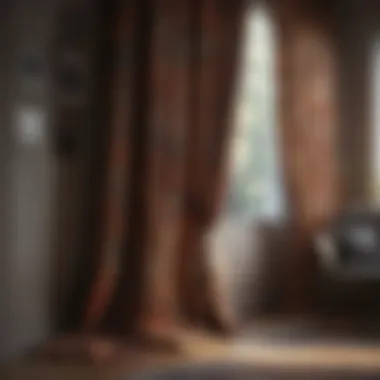

Another advantage is their ability to guide the eye throughout the room, enhancing spatial perception. Nonetheless, overuse of geometric patterns can result in a sterile environment, so moderation is key.
Stripes
Stripes are classic and versatile. They can make a space feel taller or wider, depending on their orientation. Horizontal stripes can create visual width, while vertical stripes add height. This characteristic makes them an advantageous option for smaller rooms.
Yet, there is a chance that stripes might be interpreted as overly formal, especially in bold colors. Thus, it’s important to find a design that fits the overall theme of the living room.
Curtain colors and patterns are not mere decorative choices; they are essential elements that forge the character of your living space. By making thoughtful selections, one can enhance both the style and function of the room.
Measurements and Installation
Understanding measurements and installation is crucial when selecting curtains for your living room. The right size and proper installation can transform a space, enhancing its overall aesthetics and functionality. Incorrect measurements can lead to curtains that do not fit properly, which affects both their appearance and their performance. For instance, curtains that are too short will not provide the desired privacy or light control, while ones that are too long can create an untidy look. Therefore, taking accurate measurements is not just a suggestion; it’s an essential step that guarantees satisfaction with the final result.
Measuring Window Size
Accurate measurement of your window size is the first step in selecting the ideal curtains. This process involves measuring the width and height of the window. To find the width, use a measuring tape and record the distance from one edge of the window frame to the other. It’s advisable to add extra width to allow for the curtains to open fully without blocking any part of the window. The height is measured from the top of the window frame to the desired point where the curtains will hang, whether that be just above the window, at the window sill, or even to the floor.
Selecting Curtain Length
Choosing the right curtain length can greatly affect the overall look of the room. Common options include:
- Sill length: Ending at the window sill, this option works well in informal settings.
- Apron length: Falls just below the sill, creating a tailored look.
- Floor length: Touches the floor, adding elegance and a more formal appearance.
- Puddle length: Exceeds the floor by a few inches to create a dramatic effect.
Consider your interior design style when making this choice. For modern designs, floor-length curtains offer a clean line, while traditional spaces may embrace puddle-length options.
Hanging Methods
Rods
Using curtain rods is one of the most popular methods for hanging curtains. They provide flexibility and ease of use, allowing curtains to slide open and close smoothly. A key characteristic of rods is that they can be decorative, serving as a design element.
Advantages of rods include their availability in numerous styles—ranging from sleek modern to ornate traditional. However, they also require proper installation; incorrect placement can affect curtain functionality.
Track Systems
Track systems are another effective option for hanging curtains. They are often installed in ceiling configurations, offering a streamlined look. The advantage of track systems is their ability to support heavier curtains and facilitate smooth movement, especially for panel drapes.
Unique feature of track systems is the low-profile appearance, which does not detract from the curtains themselves. On the downside, they may be less flexible in terms of style compared to rods.
Hooks
Hooks are often used in combination with rods or tracks as a hanging method for curtains. They can easily attach to the curtain fabric and allow for quick adjustments. Their main characteristic is versatility, as they can be spaced closely or widely apart based on the desired look of the curtains.
The benefits of using hooks include an adjustable installation and variety of styles that can match any decor.
In summary, accurate measurement and thoughtful installation are critical to achieving the desired outcome with curtains in your living room. Each hanging method has its own set of advantages and considerations, so selecting the one that best suits both your style and functional needs is essential.
Incorporating Curtains with Interior Design Styles
In the realm of interior design, curtains hold a significant role that often goes unnoticed. They are not just functional items for privacy or light control, but they also serve as vital design elements that can unify or contrast different aspects of a living room. When chosen thoughtfully, curtains can enhance the overall aesthetic of a space, adding texture, color, and character. This section delves into the various ways to incorporate curtains with distinct interior design styles, illustrating their importance in achieving a cohesive look.
Modern
Modern design is characterized by its clean lines, minimalism, and a focus on functionality. Curtains in such a setting should complement these elements rather than overwhelm them. For a modern living room, opting for sheer or lightweight fabrics is a good choice. This choice maintains an airy feel while providing necessary light control. Colors should remain neutral or monochromatic, perhaps with subtle geometric patterns, to align with the overall design philosophy.
Consider using mounting systems that keep the curtain framework hidden, such as ceiling-mounted tracks. This further enhances the modern aesthetic and allows for an uninterrupted view. Additionally, streamlined curtain designs, such as simple grommet-top styles, resonate well within modern themes.
Traditional
Traditional design evokes a sense of elegance and timelessness. Incorporating curtains into traditional living rooms often involves rich fabrics, detailed patterns, and classic draping techniques. Heavy materials like velvet or damask are suitable choices, providing depth and luxury. Shades of deep burgundy, royal blue, or forest green can also bring a classic touch.
Layering is essential in traditional interiors. Base layer curtains made of lighter fabrics can be paired with heavier drapes, creating a more cozy and welcoming environment. Patterns like floral or paisley are significant, adding a touch of sophistication and warmth to the space. Long, flowing curtains that pool slightly on the floor can amplify the grand feeling of a traditional living room.
Transitional
Transitional design offers a perfect balance between modern and traditional styles. This approach allows flexibility in incorporating curtains. A selection may include both airy fabrics and ornate patterns, resulting in a harmonious mix. Colors can transition from soft neutrals to rich hues, suitable for both aesthetics, making it easier to tailor the space to personal taste.
Curtains in transitional designs can feature textures that combine elements from both styles. For instance, linen sheers can be paired with a patterned cornice that reflects traditional designs. Such an approach softens stark modern elements while retaining functionality. As such, transitional spaces benefit from the versatility that curtains provide, helping to create an inviting atmosphere.
Layering Curtains for Added Depth
Layering curtains create an opportunity to enhance the visual impact of a living room. This technique allows homeowners to introduce complexity and a sense of style to their spaces. The right combination of curtain styles, textures, and colors can not only frame a window beautifully but also contribute to a more inviting atmosphere. By layering curtains, one can also address practical considerations such as light control and privacy.
Choosing how to layer curtains is essential. Effective layering involves a base layer and overlays, each playing a distinct role. The base layer typically provides the fundamental function, while overlay options can add flair and style to the overall design.
Having a layered curtain setup can offer several advantages. It can help to control the light entering a room, allowing for variable light settings depending on time of day. Additionally, by using different fabrics and colors, it gives the room character and can tie the decor together.
Base Layer Curtains
Base layer curtains serve as the primary set of curtains. These usually are heavier, providing necessary coverage and insulation. Selecting the right fabric is crucial as it impacts both form and function. Fabrics like linen or cotton work well as they are available in various colors and patterns, fitting seamlessly with the rest of the decor. They can establish a backdrop that complements overlay options.
The selection of the base curtain should be dependent on the desired level of light control and privacy. It is important to consider how these curtains will interact with the overlays. A solid color base can provide a neutral foundation, while patterned options may introduce an element of fun to the room.
Overlay Options
Overlaying additional curtains can introduce layers of complexity and style.
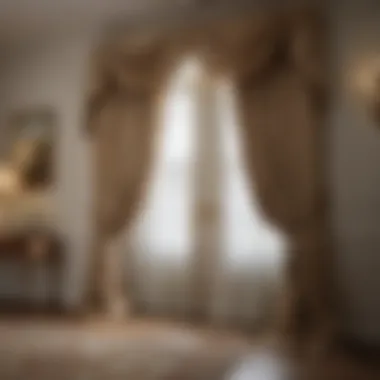

Sheer Overlays
Sheer overlays are a favored choice for many homeowners. These delicate curtains allow natural light to filter through while providing a measure of privacy. The primary characteristic of sheer curtains is their translucence, which softens the incoming sunlight. This quality makes sheer overlays excellent for creating a light and airy feel in a living room.
Adding sheer curtains as an overlay can significantly enhance the aesthetic, offering a beautiful contrast with thicker base curtains. The main advantage of sheer overlays is their versatility; they can dramatically change the mood within a space depending on how they are combined with the base layer. One should be mindful, however, as sheer curtains provide minimal privacy and might not block out light entirely.
Valances
Valances offer a different approach to layering. They are shorter curtains that hang above the window, often solely used for decoration, rather than for covering windows. Valances can introduce additional color and texture, emphasizing the style of the room. The key characteristic of valances is that they can be combined effectively with other curtains without overwhelming the overall design.
One of the unique features of valances is their ability to unite different curtain elements without making it feel cluttered. They can also hide curtain hardware, creating a cleaner look. However, they typically do not provide much in terms of privacy or light control, which is crucial to keep in mind when planning a layered curtain arrangement.
Layering gives homeowners a chance to express their individual style, all while enhancing function and aesthetics in their living areas.
Maintaining and Cleaning Curtains
Maintaining and cleaning curtains is an essential aspect of interior decor that often gets overlooked. Curtains serve both functional and aesthetic purposes in a living room. Regular upkeep not only enhances their appearance but also ensures longevity and functionality. Dust, allergens, and stains can accumulate on curtains, diminishing their beauty and affecting indoor air quality. Cleaning them prevents these issues and keeps your living environment fresh and inviting.
Moreover, the maintenance process varies depending on the material used. Sheer curtains require delicate handling, while thicker fabrics can withstand more robust cleaning methods. Understanding the specific needs of your curtains can save time and prevent damage. Additionally, regularly maintained curtains can resist fading, ensuring they remain vibrant and appealing over time.
In the following subsections, we will explore practical tips for regular maintenance and effective methods for removing stubborn stains, ensuring your curtains contribute positively to your living space.
Regular Maintenance Tips
Keeping curtains in good condition involves straightforward practices. Here are some essential maintenance tips:
- Dusting: Use a soft cloth or a vacuum cleaner with a brush attachment to remove dust and dirt. This should be done at least once a month.
- Washing: Follow the manufacturer's care instructions. Generally, curtains made from cotton or polyester can be machine washed. For delicate fabrics, hand washing is recommended.
- Avoid Sun Exposure: Rotate your curtains occasionally to limit sun exposure on any one area. This can help prevent fading.
- Check for Damage: Inspect curtains for signs of wear, like frayed edges or broken hooks. Addressing these issues promptly keeps curtains looking their best.
Incorporating these maintenance habits can prolong the life of your curtains while enhancing your room’s decor.
Stain Removal Techniques
Stains can be a persistent issue with curtains, but many effective removal techniques exist. Here are some methods tailored to common stains:
- Water-Based Stains: Mix mild detergent and water. Dab with a clean cloth to lift the stain. Rinse with water and blot dry.
- Grease Stains: Apply corn starch to absorb the grease. Leave it for a few hours before brushing off and follow with water-based cleaning.
- Wine or Juice Stains: Blot immediately with a clean cloth. Use a mixture of hydrogen peroxide and dish soap. Apply gently and rinse thoroughly.
Using warm water can often enhance stain removal, but check fabric care labels first.
- Ink Stains: Dab the stain with rubbing alcohol using a cotton ball. Rinse well afterward.
For difficult stains, it may be wise to consult a professional cleaner. Regular cleaning and prompt stain treatment can keep your curtains looking pristine for years.
Budget Considerations for Curtains
When it comes to selecting curtains for your living room, budget considerations play a crucial role in the decision-making process. Understanding the cost aspects helps homeowners balance style and practicality. Curtains can significantly impact the overall look of a room, but their price can vary greatly based on materials, design, and installation methods. Being mindful of your budget ensures you make informed choices without compromising on quality or aesthetic appeal.
Cost of Materials
The primary factor influencing your curtain budget is the cost of materials. Different fabrics come with varying price points. For example, natural fibers like linen and cotton tend to be more expensive than synthetic alternatives such as polyester or nylon. Here’s a brief overview of common materials:
- Natural Fibers: Tend to offer a more luxurious look and feel. Prices may range widely based on brand and quality, usually costing 20% to 50% more than synthetics.
- Synthetic Fabrics: Generally more affordable and easier to clean. Products like polyester can sometimes be found at lower price points, which makes them appealing for families or those on tight budgets.
To optimize your budget, it is essential to consider how often you will use the curtains and whether the longevity of high-quality materials justifies the initial investment.
DIY vs. Professional Installation
When determining your curtain budget, you'll also need to assess whether to tackle the installation yourself or hire a professional. Both options have their merits and potential drawbacks.
- DIY Installation: This option is often seen as cost-effective. If you have some basic tools and a bit of skill, you can save on labor costs. Moreover, there are numerous online tutorials available that guide you through measuring, cutting, and hanging curtains. Just be mindful that mistakes can lead to increased expenses if you need to replace or adjust items later.
- Professional Installation: Hiring a professional can ensure the job is done correctly and efficiently. This is particularly useful for more complex window treatments or larger spaces. However, this convenience comes at a price. Professional services could add 10% to 30% to your overall budget, which should be factored into your decision.
"Budgeting for curtains involves understanding all elements of costs and making choices that align with your overall interior design plan."
Prioritizing what is most important to you—whether that is high-quality materials, convenience of installation, or both—is essential in creating a harmonious living space.
Final Thoughts on Choosing Curtains
Curtains play a crucial role in defining the overall aesthetic and functionality of a living room. When considering the various options available, one must take into account factors such as style, material, color, and installation methods. The right curtains can significantly enhance the ambiance, offer privacy, and control light exposure, making them an essential element in living room design.
Importance of Thoughtful Selection
Selecting curtains is not merely a decorative decision. It involves understanding how they interact with the space. Elements like the size of the windows, height of the ceiling, and surrounding decor should guide choices. For example, opting for long, flowy drapes can create an illusion of taller windows, while shorter, structured curtains may suit more casual or modern spaces.
Additionally, the functionality of curtains can add value to this selection process. Do you need blackout curtains for a media room? Or perhaps sheer curtains for a bright, airy feel? Consideration of these functionalities can ensure curtains meet practical needs while also aligning with design visions.
Overall Cohesiveness
To achieve a cohesive living room design, it is vital to harmonize curtains with other elements in the space. Patterns and colors should either complement or contrast effectively with furnishings and wall colors. A well-matched design enhances the aesthetic appeal and creates a unified look. In reality, differing textures or shades can be advantageous as they bring a layered effect, enriching the overall decor.
Practical Considerations
Budget constraints and maintenance are other vital facets of curtain selection. Understanding the cost of various materials can guide homeowners on what to invest in while maintaining quality. Similarly, each type of fabric requires different levels of care. For instance, cotton curtains might need regular washing, while polyester might need less frequent attention.
In essence, thoughtful material selection not only reflects personal style but also addresses practical implications, making the living space both beautiful and functional.
"The right curtains can transform not only a room's aesthetics but its atmosphere."
Time Investment
Investing time into researching and selecting curtains is worthwhile. The decision should not be rushed. Explore styles, reach out to interior designers, or even observe how others have styled their spaces. Gaining insights can illuminate preferences and guide better choices.
Closure
In summary, thoughtful consideration when choosing curtains for the living room results in an informed purchase that enhances both the design and utility of the space. By evaluating personal needs, matching decor, and respecting budget constraints, homeowners can ensure their curtain selections are not only pleasing to the eye but also functional, creating a living room that is inviting and stylish.

